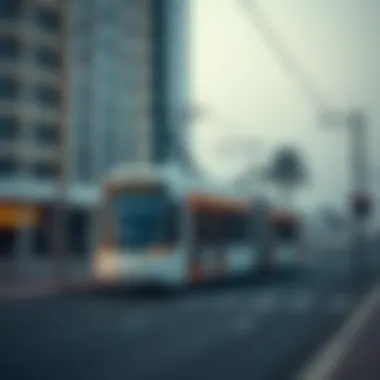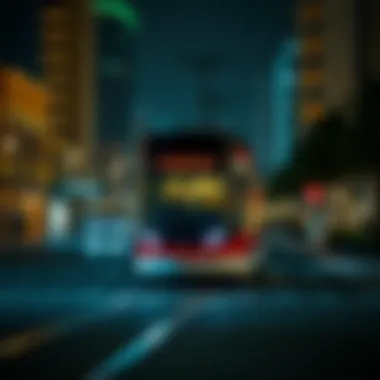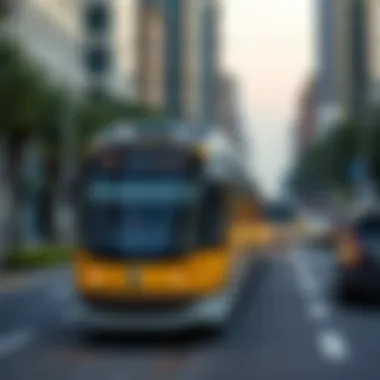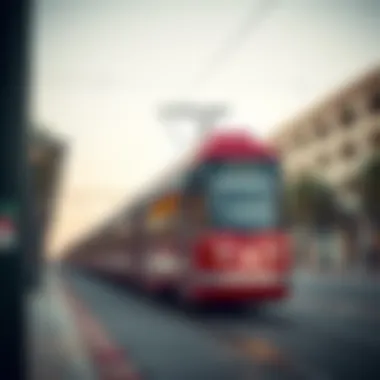Tram Timing in Dubai: A Complete Guide


Intro
In a city as bustling and vibrant as Dubai, understanding how to navigate its tram system can greatly enhance one's experience, whether you're a resident or just visiting. The tram lines stretch through strategic parts of the city, bridging gaps between point A and point B with efficiency. The ease of hopping on a tram makes it a preferred choice for many, especially when considering the sprawling nature of Dubai's urban landscape. Beyond convenience, the trams contribute to a sustainable transport network, encouraging a shift away from reliance on personal vehicles.
Grasping the operational timings of the tram is essential for making the most of this service. Knowing when to catch a tram can save valuable time and transform your daily commutes. This guide provides you with detailed information on tram schedules, frequency, and tips for maximizing your travel efficiency. In addition, we will explore the integration of trams within the wider transport network of Dubai, encompassing buses and metro systems. So buckle up as we delve into the significant aspects of tram timing in this thriving metropolis.
Preface to Dubai's Tram System
Dubai's tram system, launched in 2014, has become a pivotal part of the city’s transport landscape. Understanding its workings is not just about knowing when to hop on a tram; it’s about grasping how it enhances the entire urban setting. With a blend of modernity and efficiency, the tram connects various districts of Dubai, promoting easier movement for residents and tourists alike. As Dubai continues to grow, the tram system stands out as a vital asset.
Overview of Tram Development
The inception of the Dubai Tram was not merely a whim. Years of planning culminated in a transit system that would serve as a backbone for sustainable transport. Designed to ease the congestion often seen on its bustling roads, the tram cuts through the heart of the city, linking major attractions, business hubs, and residential areas. The entire project speaks volumes of Dubai's commitment to futuristic infrastructure. It signifies a shift towards being more pedestrian-friendly and environmentally conscious.
The tram’s route was strategically planned, stretching from Al Sufouh to Dubai Marina. Its construction tackled several challenges, including integrating seamlessly with existing transport systems, such as the Metro. Moreover, the design focuses on aesthetics and functionality, with trams that boast a sleek appearance coupled with cutting-edge technology. Each station is equipped with features that enhance user experience, from waiting areas to digital information displays.
Significance in Urban Transport
The tram system is a testament to Dubai's aspirations. It plays a critical role by reducing reliance on cars, thus decreasing traffic jams and pollution. The benefits extend beyond mere convenience; they include significant environmental impacts, promoting a cleaner city atmosphere.
For commuters, particularly those traveling to and from the Dubai Marina or Jumeirah Beach, the tram acts as a lifeline. Young professionals, students, and tourists find a reliable option for navigating the city’s busy streets. Moreover, the tram offers a reliable means for those wanting to reach their destination without the hassles of parking or expensive taxi fares.
In broader terms, the tram contributes to the local economy. It encourages more visitors to explore the shopping avenues and attractions dotted along its route. With such a service at one's disposal, people can enjoy the attractions without the worry of transportation.
Furthermore, for individuals considering investing in property within the tram’s vicinity, this transport convenience can significantly enhance real estate value. Proximity to a tram stop typically equates to higher desirability of properties, especially in a fast-paced environment like Dubai.
Operational Hours of Dubai Tram
Understanding the operational hours of the Dubai tram is vital for both residents and visitors to navigate the city efficiently. The tram system in Dubai is designed not just as a mode of transport but also as a strategic solution to urban mobility challenges. Knowing when the trams run allows users to plan their journeys effectively, minimizing waiting times and ensuring smoother transitions between various destinations.
Weekday Scheduling
During weekdays, the tram operates from 6:00 AM to 1:00 AM the following day. This extended schedule accommodates the busy lives of commuters who rely on the tram for regular travel. Sedentary office-goers can utilize the early morning trams to reach their workplaces, while night owls have the flexibility of last trams after hours, making it convenient to return home. This thoughtful timing aligns with the pulse of Dubai's vibrant economy, catering to a diverse population.
- Peak Hours: Generally, the busiest periods are during the morning rush from 7:00 AM to 9:00 AM and the evening rush from 5:00 PM to 8:00 PM. During these times, trams are more frequent, ensuring that commuters are not left stranded.
- Off-Peak Periods: Conversely, after 9:00 AM and before 5:00 PM, the tram frequency decreases. However, this provides a quieter experience for those traveling mid-day, making it a better option for shopping trips or casual outings.
Keeping an eye on these scheduling nuances is crucial as they play a significant role in the daily commuting experience for many individuals.
Weekend Considerations
On weekends, the operational hours adjust slightly. Trams generally run from 9:00 AM to 1:00 AM, offering a later start to the service. This allowance recognizes that many residents enjoy a more relaxed pace on Fridays and Saturdays, allowing them to sleep in a bit longer.
- Increased Frequency: Weekend services cater not just to the nightlife but also to families and tourists visiting attractions along the tram routes. The trams run more frequently during peak hours, which are typically between 10:00 AM and 12:00 PM and later from 5:00 PM onwards. This enhances the convenience of getting around the city.
- Event-Driven Adjustments: It's also worth noting that special events could lead to changes in operational hours. For instance, if there are festivals or major sports events occurring, riders should stay alert to alterations in the schedule by checking the tram's official app or website.
In summary, awareness of the operational hours helps maximize the tram system's benefits. Tapping into the tram's schedule can turn ordinary trips into effortless journeys through the sprawling cityscape of Dubai. Whether it’s for work or leisure, the tram ties into the fabric of the city, making it a reliable option for everyone.
"Knowing the tram timings can save you from hustle and bustle, making your trip as smooth as silk."
For real-time updates and detailed schedules, you can visit Dubai's official transport website or refer to community forums on Reddit where locals share their tips.
Frequency of Tram Services
The frequency of tram services plays a crucial role in ensuring a smooth commuting experience for both residents and tourists in Dubai. Understanding how the tram operates can make the difference between a stressful travel day and a hassle-free journey across the city. The reliability of tram services directly affects the overall efficacy of the public transportation system in Dubai, as well as its attractiveness compared to other modes of transport. High-frequency services can create a vibrant urban environment by enabling more people to utilize public transport, thereby reducing congestion on the roads.
Peak Hours vs Off-Peak Hours
When discussing tram frequency, it's essential to note the distinction between peak and off-peak hours. During the weekdays, especially from 7:00 AM to 9:00 AM and from 5:00 PM to 8:00 PM, trams run more frequently to accommodate the surge of commuters heading to work or returning home. Services can operate every seven to ten minutes during these busy periods, maximizing the chances to board without a long wait.
Conversely, during off-peak hours, such as mid-morning or late evening, trams may run less frequently. This might mean waiting intervals stretching up to fifteen to twenty minutes. Understanding this scheduling is beneficial for riders planning their journeys, particularly if timing is tight.
"Knowing when the trams are busy can drastically improve your travel efficiency and experience."
Tram Interval Timing
Interval timing refers to how often the trams arrive at stops. This is a vital component of overall service reliability. With a well-timed schedule, passengers can make informed decisions on when to head out, reducing uncertainty in transit times. The Tram system in Dubai has set intervals based on time of the day, which reflect the demand patterns.
For example:
- Morning Peak (7 AM - 9 AM): Trams arrive every 7-10 minutes.
- Midday (9 AM - 5 PM): Frequency may reduce to every 12-15 minutes.
- Evening Peak (5 PM - 8 PM): Trams again become more frequent, every 7-10 minutes.
- Night Services (8 PM - Midnight): Arrival intervals may extend out to every 20 minutes.


This structure is designed to balance operational efficiency with passenger needs. Commuters can benefit greatly from these timings by planning their trips accordingly, ensuring they've ample time to catch the next tram. Knowing the patterns in tram frequency is not just helpful—it's essential for a seamless urban transportation experience.
Tram Routes and Key Stations
The tram system in Dubai is not just a mode of transport; it's a lifeline that connects various neighborhoods, business districts, and recreational spots across the city. Understanding the routes and key stations is essential for anyone looking to maximize their travel efficiency within this vibrant metropolis. With a well-planned network, the tram services not only ease the commute for residents but also cater to a steady stream of tourists exploring the attractions scattered around the city.
Main Tram Lines Overview
Dubai's tram network comprises several main lines that span significant portions of the city. The Red Line, for instance, runs from the Al Sufouh area to the Dubai Marina, intersecting numerous high-traffic areas along the way. This line is particularly vital as it connects to the Dubai Metro, making it easier for commuters to switch between the tram and metro systems seamlessly. Meanwhile, the Blue Line extends from the Mall of the Emirates to the Jumeirah Beach, providing access to key leisure spots that are often packed with visitors, especially during weekends.
The importance of these tram lines cannot be overstated. Each line is strategically designed to reduce congestion on the roads by offering alternatives that are both efficient and reliable. In addition, the tram services operate with modern technology, ensuring a smooth ride and reduced waiting times compared to other forms of transportation.
Key Stations
Prominent stations along these lines, such as Dubai Marina Station and Al Sufouh Station, have been meticulously chosen based on their accessibility and proximity to commercial hubs. At these key points, passengers can enjoy numerous amenities including ticketing kiosks, digital information displays, and waiting areas that prioritize passenger comfort.
- Dubai Marina Station: Serves as a pivotal point for tourists due to its close proximity to attractions like the Marina Walk and beach areas. It often sees high foot traffic, especially during peak times.
- Al Sufouh Station: This station provides easy access for residents heading to business districts and offering connections to bus services as well.
- Mall of the Emirates Station: A hotspot for shoppers, this station connects directly to one of Dubai's largest shopping malls, making it a bridge between retail and transport.
Each station not only facilitates tram boarding and alighting but also serves as a hub where travelers can strategize their next moves, whether it involves hopping onto a bus or continuing their journey via metro.
Connecting Points with Metro and Bus Services
Integration with other transport modes is crucial in modern urban transport systems. Dubai’s tram stations act as connective tissues in the city's broader mobility infrastructure. Almost every tram station interfaces directly with metro lines or bus services. For example:
- Those boarding at Al Sufouh Station can transfer easily to the metro, enhancing mobility further into the city.
- Similar connections exist at major spots like Mall of the Emirates Station, ensuring a smooth transition whether passengers choose rail or road.
Significance of Integration
This seamless connectivity offers several benefits:
- Enhanced Mobility: Passengers can switch from tram to metro within minutes, essentially reducing journey time across the city.
- Accessibility: Increasing access to all corners of Dubai, the tram system serves a diverse demographic including expats, tourists, and locals.
- Cost Efficiency: Travelers benefit from various fare packages that can be utilized across multiple transport systems, sometimes at a discounted rate.
Real-time Tram Information Access
Understanding tram timings doesn't just stop with schedules and routes; real-time information plays a pivotal role in enhancing the commuting experience in Dubai. With the constant flow of passengers, the ability to access up-to-date tram information makes journeys efficient and less stressful. As more and more people rely on the tram service for their daily commutes, having immediate access to tram timings leads to better planning and improved satisfaction of services.
Without a doubt, the integration of technology into public transport systems has been a boon. We’ll delve into two noteworthy methods for accessing up-to-the-minute tram information: mobile applications and digital display screens.
Mobile Applications for Tram Updates
In an era where almost everyone carries a smartphone, dedicated mobile applications provide a convenient way to stay informed about tram schedules. Applications like the RTA Dubai app keep users in the loop about tram arrivals, delays, and any service adjustments. Users can track their chosen tram in real-time, which makes understanding and planning their commutes far simpler.
These mobile apps often offer additional features, such as:
- Route Planning: Illustrating the fastest routes to reach destinations.
- Alerts and Notifications: Sending users updates on impending delays or changes to the timetable.
- Integrated Services: Connecting tram information with other transport options, such as buses and the Metro, which enhances overall trip efficiency.
Having such data at one’s fingertips truly generates confidence, allowing commuters to make informed decisions about their travel plans.
Digital Display Screens at Stations
As another layer of real-time information access, digital display screens installed at tram stations provide critical information to passengers as they await their rides. These screens showcase important details such as tram arrival times, the status of trams (whether they are delayed or on time), and even the next stops for approaching trams.
The screens are typically designed to be user-friendly and informative. They often feature:
- Clear Timelines: Showing the exact minutes until the next tram arrives.
- Emergency Updates: Displaying crucial information in case of service disruptions or emergencies.
- Promotions and Events: Keeping commuters informed about upcoming events that might affect transport schedules or introduce new tram services.
By having immediate access to information, both mobile apps and digital screens ensure that passengers can adjust their plans more effectively. To stay ahead of the bustle of city life, tapping into these resources is recommended for anyone using the tram services in Dubai.
"In an age of connectivity, accessing real-time transport information is not just a luxury but a necessity for effective urban navigation."
For more detailed transport information or app downloads, you can visit RTA Dubai.
In summary, leveraging mobile applications and digital screens enhances the commuting experience for residents and visitors alike, making the tram system not only user-friendly but also interconnected with Dubai's overall urban landscape.
Fare Structure and Payment Options
A sound understanding of the fare structure and payment options associated with Dubai's tram system is crucial. This knowledge is not only beneficial for everyday commuters but also assists visitors and those considering investments in local properties. When navigating an urban transport system, costs can significantly influence decisions about which mode of transport to choose.
Understanding Tram Fares


The tram fare in Dubai is structured to be fair and transparent. By design, it aims to balance affordability with the high-quality service the city is known for. The fare system is largely based on a zone-based model. This system means that the longer your journey spans, the higher your fare will be. For those making short hops between stations, this model can be quite economical.
The base fare includes the cost of access to the tram service plus any additional fees that might apply if crossing into different fare zones. Hence, it's essential to familiarize oneself with the zones to calculate potential costs ahead of time. Notably, some promotions may allow for free rides during off-peak hours or discounted group fares. This can make a substantial difference in the daily commute for residents.
"A penny saved is a penny earned," considering the various ways to save while commuting can really add up over time.
Payment Methods Available
Adopting a convenient payment method can greatly enhance a user's experience with the tram system. In Dubai, no one is left stranded without options. The most common payment method is through the NOL card, a smart travel card used across various transport modalities, including trams, buses, and the metro. This card allows for effortless touch-and-go access and can be topped up at vending machines or retail outlets throughout the city.
Additionally, there is the option to pay through mobile applications that many residents are already familiar with. Various apps like RTA or other partner platforms offer functionalities such as trip planning and real-time fare calculation, making daily commutes hassle-free.
For those who might forget to recharge their NOL card, several tram stations have ticket vending machines that accept cash and cards, providing a backup option at your fingertips. Furthermore, as the region continues to innovate, plans for accepting mobile payments such as Apple Pay or Google Pay may be on the horizon, reflecting current trends in digitization in public transport.
In summary, being aware of the tram fare structure and the different payment options available can significantly streamline the commuting experience, enhancing overall satisfaction with the tram system in Dubai.
Benefits of Using the Tram System
The tram system plays a significant role in Dubai's transportation network. It is not just a mode of travel but a contributing factor to a more sustainable and streamlined urban environment. The benefits of utilizing the tram system extend beyond mere convenience; it creates a ripple effect in several facets of daily life. From reducing traffic congestion to promoting eco-friendly transport, the tram system enhances overall urban livability in Dubai.
Environmental Advantages
One of the standout benefits of the tram system is its positive impact on the environment. Trams are generally powered by electricity as opposed to fossil fuels, which translates to lower emissions and a clearer atmosphere. In a city like Dubai, where rapid development can lead to an increase in pollution, trams offer a greener alternative for commuters. Consider these points:
- Reduced Carbon Footprint: By choosing trams over personal vehicles, residents help in cutting down the overall carbon output.
- Efficient Land Use: The tram’s ability to carry a substantial number of passengers in a single trip means fewer cars on the road, allowing for more open spaces and reduced demand for parking.
- Noise Reduction: Modern trams typically operate more quietly than traditional vehicles, enhancing the quality of life for those living near tram routes.
The positive environmental aspects not only benefit the city but also have been one of the key selling points for Dubai's investment in public transport infrastructure. As urban dwellers become increasingly aware of ecological impacts, using the tram might just be the ticket towards a more sustainable lifestyle.
Convenience for Daily Commutes
Daily commuting can be a chore, filled with stress and delays. However, the tram system offers a streamlined experience that many have come to appreciate. Here’s how it transforms the commuter experience:
- Predictable Timings: With trams running regularly, passengers can plan their journeys around a reliable schedule. Knowing when the next tram is due often eases the anxiety commonly associated with public transport.
- Strategic Stops: Tram stations are usually strategically located within urban centers, making them a convenient option for those whose daily activities revolve around shopping, dining, and business hubs.
- Connection Efficiency: The ease with which trams connect with other transport modes creates a seamless travel experience. As a commuter, hopping from tram to bus or metro can be done without the hassle of navigating through complex exchanges.
The introduction of the tram system has significantly reduced the time spent stuck in traffic for many. For individuals relying on public transport, the tram represents an efficient and effective choice, allowing commuters to spend their time and energy where it truly matters.
"The tram system embodies not just the spirit of modernity but also a commitment to a greener and more efficient urban lifestyle in Dubai."
By embracing the tram system, residents and visitors alike can enjoy the many facets it brings, from a more environmentally friendly footprint to smoother daily travel experiences.
Safety Regulations and Passenger Conduct
Safety and conduct aboard the tram system play a pivotal role in ensuring a pleasant and secure commuting experience in Dubai. With the increasing popularity of trams as a primary means of transportation, both safety regulations and passenger behavior become crucial elements. By adhering to these regulations, passengers can safeguard themselves and others while enhancing the overall efficiency of the tram network.
Safety Features of the Tram
The Dubai tram is designed with cutting-edge safety features to protect both passengers and pedestrians. Here are some key elements:
- Automatic Braking System: This feature can bring the tram to an immediate halt if it detects an obstacle on the tracks, minimizing accident risks.
- CCTV Surveillance: Cameras are strategically placed throughout the tram and at stations, enhancing security and helping to deter criminal activities.
- Fire Alarm Systems: Every tram is equipped with a sophisticated fire detection and alarm system to alert passengers and operators immediately if smoke or fire is sensed.
- Emergency Exits: Clearly marked emergency exits are present in every tram, ensuring that passengers know how to evacuate swiftly in case of an emergency.
These features reflect the commitment to maintaining passenger safety, enhancing confidence in using the tram system.
Passenger Etiquette Guidelines
Good manners and respect for fellow travelers are essential for a harmonious environment on the tram. Here’s a list of guidelines for passengers to follow:
- Wait for Passengers to Disembark: Before boarding, allow exiting passengers to leave. This simple act can ease congestion and improve flow, ensuring everyone can use the tram more effectively.
- Keep Noise Levels in Check: Whether engaging in a phone call or having a chat with friends, being considerate of noise levels creates a more pleasant experience for all.
- Offer Seats to Those in Need: If you see elderly passengers, pregnant women, or individuals with disabilities, offer them your seat. It reflects kindness and enhances the community spirit.
- No Eating or Drinking: To maintain cleanliness inside the tram, it’s advised to avoid consuming food or drinks. Spills can create hygiene issues and inconvenience for the staff responsible for maintenance.
- Keep Personal Items Secure: Keep bags and belongings close to prevent tripping hazards and to ensure that everyone has enough space to navigate comfortably.
"A smooth ride is ensured when every passenger plays their part in maintaining safety and courtesy."
By observing these guidelines, tram users contribute to making the system safer and more enjoyable for everyone. Together, safety features and passenger conduct create an efficient and harmonious environment that enhances daily commutes in Dubai.
Integration with Other Transport Modes
The integration of the tram system with other transport modes is pivotal to making Dubai’s urban mobility seamless and efficient. This approach not only alleviates congestion but also ensures that residents and visitors can navigate the city without the hassle of switching transport modes. With Dubai being a global metropolis, ensuring smooth transportation connections is essential for fostering economic growth and ensuring mobility for all.
By understanding how tram services connect with metro systems and bus routes, users can optimize travel plans and save valuable time. Let's dive deeper into these elements.
Seamless Transfers to Metro System


The tram system in Dubai is specifically designed to facilitate convenience in transfers to the metro. Key tram stations strategically intersect with metro hubs, allowing passengers to shift from one mode to another with minimal fuss. This setup is not just about location but also the well-thought-out schedules that often sync with metro arrival times. For instance, if you're hopping off the tram at the Jumeirah Lakes Towers station, you’ll find the metro station just a few steps away, streamlining your journey.
Within this nexus of connectivity, travelers can easily plot out their routes. The integration reduces the waiting time by harmonizing the schedules. Moreover, signage at tram stations clearly announces connections to the metro, alleviating any confusion about where to go next.
"The convenience of seamless transfers is a game-changer for many commuters in Dubai, providing an integrated transport experience that prioritizes efficiency and accessibility."
Connecting Bus Services
Apart from the metro, the tram system also dovetails with a network of bus services throughout Dubai. These connections create an extensive public transport ecosystem that minimizes the need for private vehicle usage. You can find numerous bus stops adjacent to tram stations, allowing smooth transitions from tram to bus without stepping out of the transport hub frame.
This connection serves not only as a practical solution for daily commuters but also for tourists exploring the city. By hopping on a tram, then easily transferring to a bus, travelers can reach various tourist attractions like the Dubai Marina or the Global Village.
- Benefits of tram and bus connectivity:
- Wider Reach: Access to a broader range of destinations without relying on taxis or personal vehicles.
- Cost Efficiency: Fares are often subsidized for transfers, providing a budget-friendly option for extensive travel.
- Environmental Impact: Utilizing public transport reduces the carbon footprint, aligning with Dubai’s sustainability goals.
Future Prospects of Dubai Tram System
As Dubai continues to evolve into a global city, the role of the tram system in its transport landscape becomes ever more crucial. The tram system is not just an addition to the existing transportation network; it is a transformative element that reflects the ambitions of the city planners and the needs of its residents. The future of this system holds great significance, as it promises to enhance connectivity, reduce congestion, and contribute to the overall sustainability of urban mobility in Dubai.
Planned Expansions and Upgrades
With the successful introduction of the tram system, planners are taking a long, hard look at how they can expand and upgrade the existing network. The goal is to make travel not just easier but also more efficient for everyone. Some planned expansions include extending the tram lines to under-served areas of the city and connecting them to new developments and residential neighborhoods. This expansion would likely cover regions like Dubai Marina, Jumeirah Beach, and even up to Al Furjan, providing residents with seamless access to essential services and public spaces.
In addition to physical expansions, upgrades to current tram vehicles are also under consideration. These upgrades may include enhancing passenger comfort, increasing capacity during peak hours, and implementing green technologies to reduce the carbon footprint. The potential introduction of new tram models with updated features signifies an important step toward modernizing the entire system. Investing in infrastructure that meets future demands is key; after all, no one wants their tram ride interrupted due to overcrowding.
"Investing in the tram expansions is not just about more routes; it's about enhancing the quality of life for residents and understanding the intrinsic benefits of a connected community."
Technological Innovations on the Horizon
Alongside physical upgrades and expansions, technological innovations are crucial for shaping the future of the tram system. Smart technology is rapidly becoming the backbone of urban transportation, and Dubai is no exception. Future tram services might integrate real-time tracking systems, allowing passengers to receive updates directly on their mobile devices regarding tram timings and delays. This feature can significantly improve the commuting experience, offering transparency and reliability.
Moreover, the potential use of data analytics can enhance route planning and service frequency, ensuring that trams are available where and when they are needed most. The use of renewable energy sources to power tram operations, like solar panels and wind energy, can also be explored, aligning with the Emirate's sustainability goals. Additionally, the integration of autonomous tram systems is not so far-fetched. It's a concept that may seem straight out of a sci-fi movie, but trials in other countries have shown promise. Adopting such technology can drastically increase efficiency and safety, paving the way for a future where transportation is not just diverse but smart.
As Dubai continues to set its sights high, the tram system's future reflects a commitment not just to transport, but to community connectivity, environmental responsibility, and technological advancement. Investors, home buyers, and residents can benefit from these developments, as well as grasp improved access to areas previously deemed challenging to navigate.
Challenges Facing the Tram System
The tram system in Dubai is an impressive asset to the city's transportation network, contributing significantly to urban mobility. Yet, like any public transport system, it grapples with its fair share of challenges. Addressing these issues is not just about improving service; it’s about ensuring that the tram continues to meet the needs of Dubai's diverse population.
Operational Limitations
Despite its sleek design and modern amenities, the tram system faces operational limitations that can affect its reliability. Limited coverage area is one of the primary constraints. Currently, the tram doesn’t connect every neighborhood, potentially leaving areas underserved. This selectivity can lead to increased dependency on other transport modes, like buses or taxis, for those whose destinations aren't conveniently located near tram stations.
Maintenance issues also surface from time to time, which can disrupt services. These snags complicate the efficient flow of operations, leading to longer waiting times for passengers. Moreover, factors like traffic congestion can affect tram timing. Although trams operate on dedicated tracks, they can experience delays due to intersecting road traffic at certain points, which can confuse riders more accustomed to using precise schedules.
Public Perception and Acceptance
Public perception of the tram service is vital for its success. There exists a variety of opinions amongst residents and visitors, with some praising its efficiency and ease of use, while others share concerns about reliability. User experience plays a key role in shaping these opinions. Regular riders who encounter delays may become disillusioned, leading to reduced patronage over time.
Additionally, there's a level of skepticism about safety. Studies show that first-time users often hesitate to try the tram system due to fears about personal safety and the unknown aspects of navigation. Educating the public about the safety features—like surveillance and well-trained staff—could bolster confidence and encourage more people to hop aboard.
In summary, the tram's challenges, from operational limitations to public acceptance issues, underscore the need for ongoing evaluation and improvement. Addressing these challenges not only enhances the overall experience for commuters but also strengthens the transport framework of this bustling city.
"The only way to do great work is to love what you do." - Steve Jobs
For further reading on transportation discrepancies in urban settings, consider checking resources like City Lab or Transport Reviews.
If you are looking for more statistical insights and reports, resources such as World Bank Transport offer a wealth of information.
Culmination
The tram system in Dubai is more than just a mode of transportation; it represents a pivotal aspect of the city’s urban framework. Its efficiency and integration with other transport modes makes it a vital entity for both residents and visitors. Comprehending the timing and schedules of this tram service can significantly enhance the commuting experience in an increasingly connected city.
Summary of Key Points
Throughout this article, we explored various essential elements that contribute to the effectiveness of the tram system in Dubai. Key points include:
- Operational Hours: Understanding the distinct schedules for weekdays and weekends helps in planning trips wisely.
- Frequency of Services: Knowing the difference between peak and off-peak hours allows commuters to expect shorter waits during high-demand times.
- Tram Routes: Familiarity with tram lines and their key stops supports smoother transitions across the city.
- Real-time Information: Utilizing digital tools and apps provides updates on tram timings and facilitates better decision-making.
- Fare Structure: Awareness of fare options assists riders in budgeting correctly for their travel.
- Safety and Etiquette: Recognizing the importance of safety features and acceptable passenger behavior ensures a pleasant journey for all.
Final Thoughts on Tram Utilization
The utilization of the tram system presents a tapestry of opportunities for enhancing mobility within Dubai. With its timely services, eco-friendly impact, and user-centric approach, opting for the tram can lead to a more sustainable urban experience. For those investing in property or services in Dubai, understanding this transport network is not just beneficial; it's essential.
As you navigate the ever-evolving landscape of Dubai’s urban offering, the tram serves as a reliable partner, bridging gaps between various locales and promoting a seamless travel experience.
"Public transport is the glue that holds urban communities together; understanding its dynamics can elevate our interactions with the city."
For further insights on Dubai's tram system and to remain updated, consider visiting Dubai's Roads and Transport Authority and platforms such as Wikipedia for additional resources.









